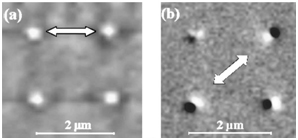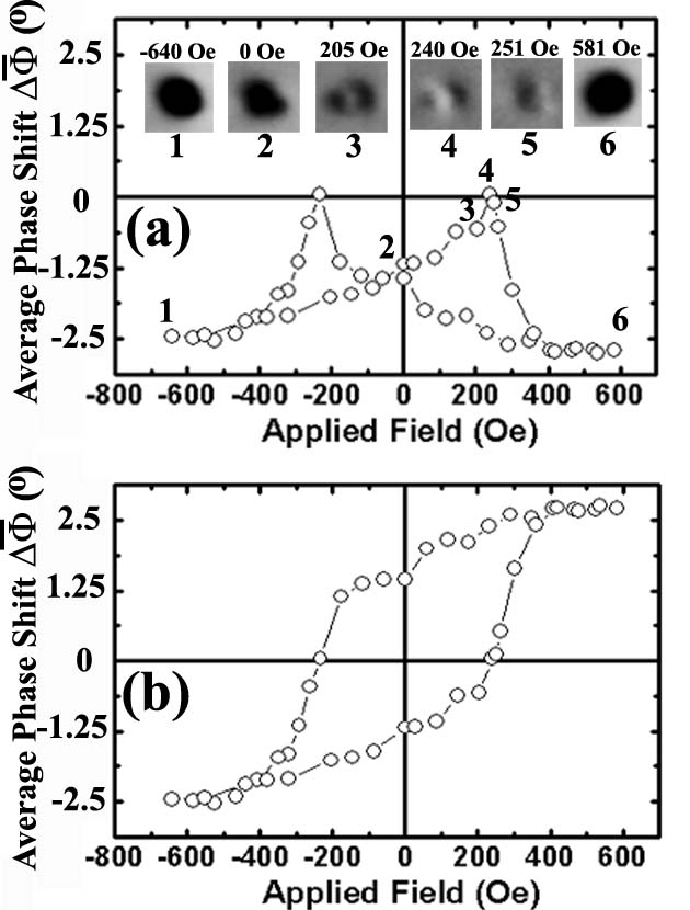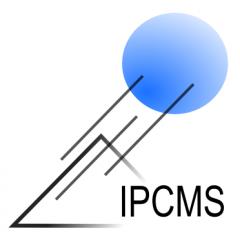Nanoscale magnetic domains in mesoscopic magnets
The basic magnetic properties of three-dimensional nanostructured materials can be drastically different from those of a continuous film. High-resolution magnetic force microscopy studies of magnetic submicrometer-sized cobalt dots with geometrical dimensions comparable to the width of magnetic domains reveal a variety of intricate domain patterns controlled by the details of the dot geometry. By changing the thickness of the dots, the width of the geometrically constrained magnetic domains can be tuned. Concentric rings and spirals with vortex configurations have been stabilized, with particular incidence in the magnetization reversal process as observed in the ensemble-averaged hysteresis loops.

2D arrays of magnetic dots with controlled size
Magnetization reversal and switching of sub-micrometer dots have been studied by magnetic field dependent, phase detection MFM. This approach has been tested on mono-domain Co particles embedded in a SiO2/Si substrate. The switching mode of the magnetization of a single dot can be identified and its hysteresis loop can be obtained. By varying the aspect ratio of electrochemically grown 200 nm cylindrical cobalt dots moves the easy magnetization direction from perpendicular to axial configuration.

Arrays of cobalt nanoparticles have been grown by electrodeposition into nano-cavities machined in a Si wafer by focused ion beam (FIB). By varying the dimensions of the cavities, it is possible to change the ratioheight/diameter (H/D) of the dots(Figure 2). As shown in the figure the magnetic properties of the dots are controlled by adjusting the ratio H/D: the magnetization is oriented out-of-plane when H/D=2 (Fig. 2a) and in-plane when H/D=1 (Fig. 2b). The importance of this result lays in the simplicity of the process: specific magnetic properties are achieved by controlling the electrochemical growth inside a beaker!It was shown that the same technique allows achieving lateral sizes of 30 nm. Such an arrangement of magnetic nano-cylinders within a 2D electron gas has attracted much interest for the study of the topological Hall effect.
Reversal of small particles
By exploiting the signal produced by a phase detection MFM under a variable magnetic field, the hysteresis and the direct visualization of the magnetic state of the particle is possible. The probe involved in the MFM imaging is made of a pyramidal tip coated by a thin film of CoCr. It is characterized independently and shows a square hysteresis with a coercitive field of 260 Oe. Images taken during field scan are analyzed one-by-one in order to calculate the total phase shift over the whole particle. In the case where the tip vibrates in the direction perpendicular-to-plane, we have demonstrated that this value is proportional to the z component of the particles magnetization.
Figure 3 shows hysteresis cycles obtained for cylindrical particles. MFM images are shown at various field values to illustrate the magnetic structure of the particles as a function of the applied magnetic field. The particle is single-domain from -600 Oe to 205 Oe, the reversal of the magnetization occurs by nucleation and domain propagation. One finds that the coercive field of the particle is reached for 240 Oe.The image correspondingto 250 Oepresentsthe same domain structure and the same signal intensity than the previous image for 240 Oe, except that thecontrast is inversed. This corresponds to the reversal of the magnetization of the probe. The square hysteresis loop of the probe allows us to infer directly the hysteresis loop of the particle (Fig. 3b) by a simple inversion of the MFM signal above 240 Oe. Thus we find for the particle shown in Figure 3, a remnant field equivalent to 50% of the saturation field (400 Oe). The reversal of the magnetization proceeds by nucleation, propagation and annihilation of domains.

